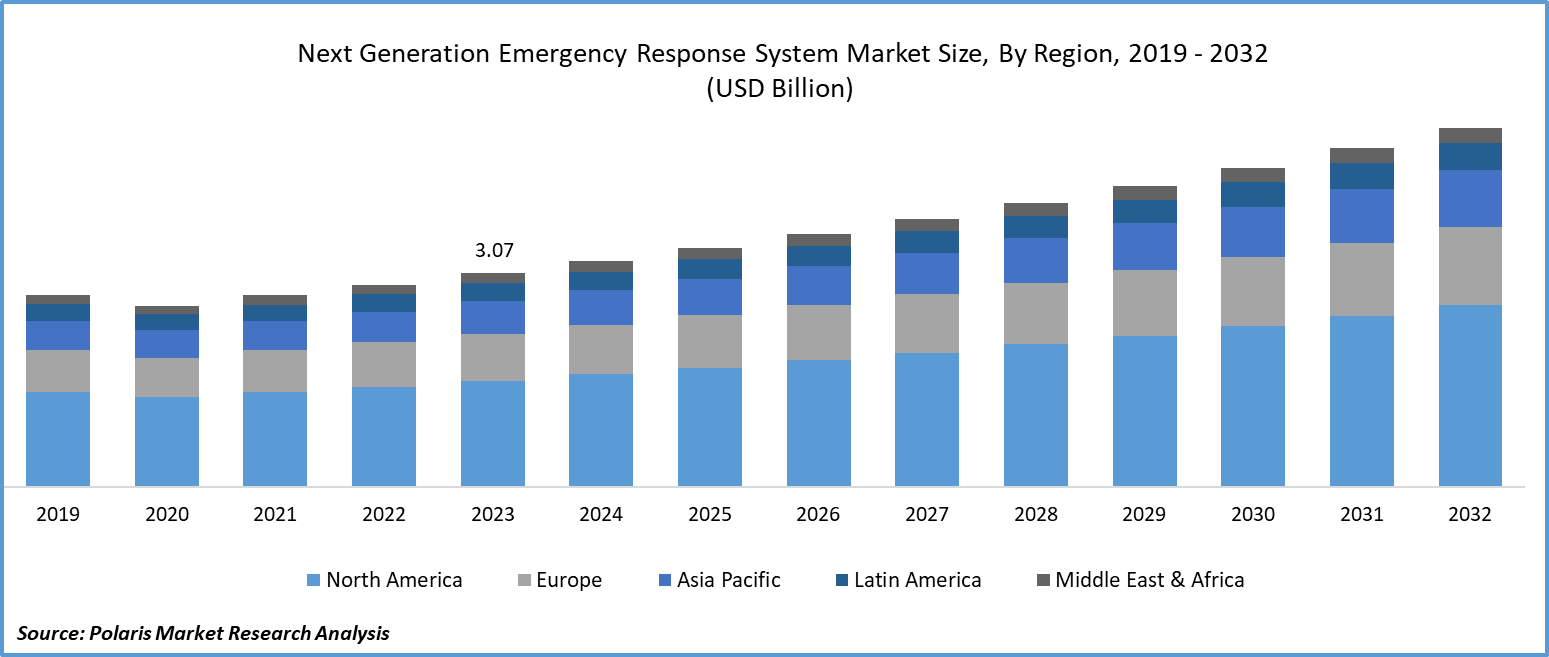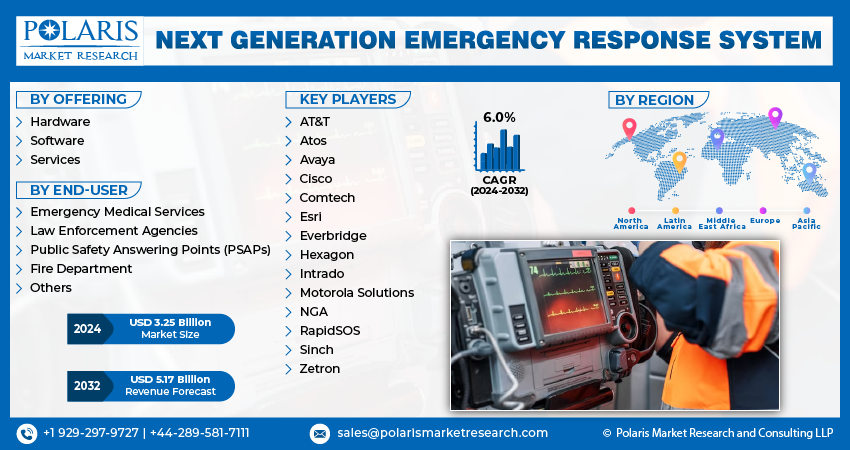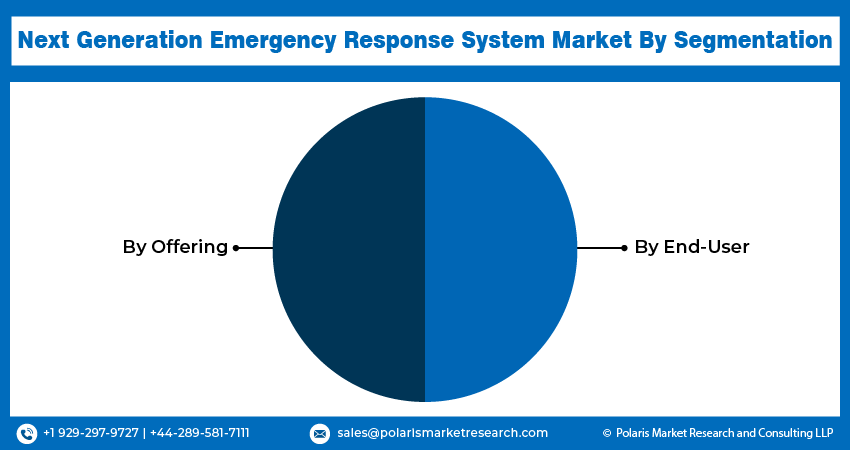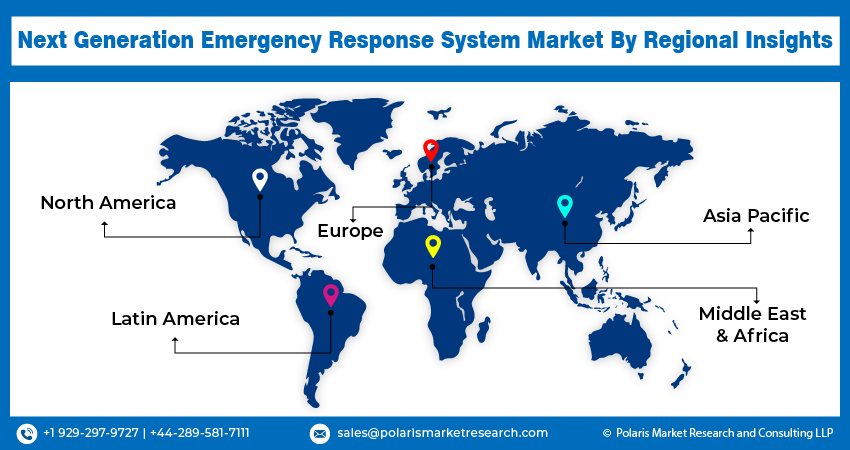
Next Generation Emergency Response System Market Share, Size, Trends, Industry Analysis Report
By Offering (Hardware, Software and Services); By End-User; By Region; Segment Forecast, 2024- 2032
- Published Date:Feb-2024
- Pages: 115
- Format: PDF
- Report ID: PM4657
- Base Year: 2023
- Historical Data: 2019 – 2022
Report Outlook
Global next generation emergency response system market size was valued at USD 3.07 billion in 2023. The market is anticipated to grow from USD 3.25 billion in 2024 to USD 5.17 billion by 2032, exhibiting the CAGR of 6.0% during the forecast period.
Next Generation Emergency Response System Market Overview
The emergency response infrastructure that is currently in use needs to be updated and aged. It may become ineffective and unreliable as a result. In order for next-generation systems to deliver more dependable and efficient service, they are being built to be more contemporary and current. Government organizations and emergency responders are becoming increasingly conscious of the necessity to invest in next-generation emergency response systems as their advantages become clearer. This is propelling global adoption of next-generation emergency response systems.
- For instance, in August 2023, Motorolla Solutions introduced CommandCentral Router, a pioneering cloud-based 9-1-1 call routing technology in the industry. This innovative solution offers public safety answering points (PSAPs) reliable and mission-critical 9-1-1 call routing performance through the cloud. CommandCentral Router is completely interoperable with every emergency call management product offered by Motorola Solutions.

To Understand More About this Research: Request a Free Sample Report
Emergencies require a system that can handle increased data volumes seamlessly, but scalability challenges arise when the infrastructure struggles to cope. Managing bandwidth, servers, and processing power become complex, impacting resource allocation. Interoperability issues arise due to NGERS combining diverse technologies with different standards, hindering communication and adaptability.
The rapid pace of technological evolution adds complexity, requiring quick integration of innovations. Integrating legacy systems and promoting collaboration among multiple agencies highlight the need for a flexible and interoperable framework. NGERS must also be adaptable to dynamic threats, incorporating new threat intelligence and community feedback for a responsive approach to emergency response.
Next-Generation Emergency Response System Market Dynamics
Market Drivers
Rising smart cities, linked cars, and IoT are projected to spur product demand.
Next-generation emergency response systems (NGERS) are evolving due to the growth of IoT, wearables, linked cars, and smart cities. Real-time data collection for proactive event identification and resource allocation is made possible by IoT sensors. Urban infrastructure is integrated into smart cities to improve communication and reduce risk. In an emergency, connected cars can provide vital information for finding and helping people. Wearable technology helps emergency responders by tracking their position and health. Better data flow and decision-making in NGERS are made possible by this networked ecosystem, which also promises increased public safety and response efficacy.
Market Restraints
The requirement of high capital and infrastructure is likely to impede market growth
The main obstacles to the development and implementation of Next-generation emergency response systems (NGERS) are financial and infrastructural. A significant upfront investment is required for sophisticated hardware, software, and sensor integration, as well as communication tools and real-time data analysis platforms. It is difficult to upgrade the current emergency response infrastructure to satisfy NGERS requirements, particularly in areas with a poor connection. The financial difficulties are exacerbated by ongoing operating expenses for things like data storage, energy use, and maintenance. It is difficult to meet regulatory requirements, handle data security and privacy issues, and achieve interoperability with current systems. Three important but difficult aspects are raising public acceptance, overcoming financial limits, and training staff. To successfully adopt NGERS for increased public safety, governments, technology companies, and emergency response agencies must work together.

Report Segmentation
The market is primarily segmented based on offering, end-user, and region.
|
By Offering |
By End-User |
By Region |
|
|
|
To Understand the Scope of this Report: Speak to Analyst
Next Generation Emergency Response System Market Segmental Analysis
By Offering Analysis
- The call management software segment accounted for a largest next generation emergency response system market share. Call management software is essential for optimizing the response process in the upcoming generation of emergency response systems. In order to speed up response times and decrease errors, it automates initial call handling and quickly gathers crucial information, including the caller's location and type of emergency. In order to quickly deploy emergency services, integration with location services guarantees precise identification of the caller's position. The software's capacity to evaluate and rank calls according to their seriousness facilitates effective resource allocation. Support for different communication channels makes it possible for the general public to share information in a variety of ways, enabling thorough data interchange. Coordination is improved by reaction teams' easy communication made possible by real-time collaborative features. Enhanced situational awareness is achieved through integration with other systems, such as GIS and security cameras.
By End-User Analysis
- The emergency medical services segment is expected to grow at the fastest CAGR during the forecast period. Integration of emergency medical services (EMS) is essential to the growth of the market development for next-generation emergency response systems. The next generation of these systems tries to provide full emergency treatment by using state-of-the-art communication technologies to enable real-time information sharing between medical specialists and emergency responders.
- Data analytics and predictive modeling allow for the most efficient use of available resources, and telemedicine and remote patient monitoring help with better decision-making and the early detection of health issues. Better event evaluation and resource deployment are made possible by drones and GIS technologies, and emergency medical personnel are kept safe and provided with important health information by wearable technology. Artificial intelligence (AI) and machine learning provide quick data analysis and the identification of critical situations.

Next Generation Emergency Response System Market Regional Insights
The North American region accounted for the largest market share in 2023
The North American region accounted for the largest market share in 2023 and is expected to maintain its dominance over the anticipated period. The growing North American market for NGERS (next-generation emergency response systems) is being driven by technological progress, increasing demands for quicker response times, and an aging population. Progress in artificial intelligence (AI), big data, and connected devices is enabling the development of sophisticated, integrated systems, enabling enhanced situational awareness and real-time data analysis. Both governments and private market players are investing in NG911, mass notification systems, public safety software, Personal Emergency Response Systems (PERS), and connected sensors to enhance emergency preparedness, response capabilities, and overall citizen safety.
The advancement of an effective next-generation emergency response system landscape in North America is enhanced through the integration of drones for aerial surveys, community alerting systems, and cybersecurity measures. Key players in the next-generation emergency response system market, including Hexagon, Intrado, Everbridge, Motorola Solutions, and AT&T, play a prominent role in this region, consistently introducing innovative solutions to address evolving market needs.
The Asia Pacific region is expected to be the fastest-growing region with a healthy CAGR during the projected period owing to notable developments, utilizing state-of-the-art technologies to improve emergency management's efficacy and efficiency. The industry seeks to offer seamless and data-driven emergency responses, with a focus on IoT-based solutions and advanced communication systems like GIS technology, 5G, and artificial intelligence. During emergencies, communication, location monitoring, and aerial observation are made easier by wearables, drones, and mobile apps. Big data analytics integration makes it possible to process enormous datasets and extract insightful information, and collaborative platforms improve coordination between different emergency response agencies.

Competitive Landscape
The next-generation emergency response system market is characterized by fragmentation and is expected to experience competitive dynamics due to the presence of multiple players. Leading service providers in the market are constantly improving their technologies to retain a competitive edge and ensure integrity, efficiency, and safety. These players emphasize partnerships, product upgrades, and collaborations to gain a competitive advantage over their counterparts and secure a substantial market share.
Some of the major players operating in the global market include:
- AT&T
- Atos
- Avaya
- Cisco
- Comtech
- Esri
- Everbridge
- Hexagon
- Intrado
- Motorola Solutions
- NGA
- RapidSOS
- Sinch
- Zetron
Recent Developments
- In May 2022, AT&T unveiled a new 911 location service aimed at reducing delays associated with standard closest cell tower routing. This innovation involves directing 911 calls from its wireless subscribers to the nearest dispatch centers, improving the efficiency of emergency response.
Report Coverage
The next generation emergency response system market report emphasizes on key regions across the globe to provide better understanding of the product to the users. Also, the report provides market insights into recent developments, trends and analyzes the technologies that are gaining traction around the globe. Furthermore, the report covers in-depth qualitative analysis pertaining to various paradigm shifts associated with the transformation of these solutions.
The report provides detailed analysis of the market while focusing on various key aspects such as competitive analysis, offering, end-users, and their futuristic growth opportunities.
Next Generation Emergency Response System Market Report Scope
|
Report Attributes |
Details |
|
Market size value in 2024 |
USD 3.25 billion |
|
Revenue forecast in 2032 |
USD 5.17 billion |
|
CAGR |
6.0% from 2024 – 2032 |
|
Base year |
2023 |
|
Historical data |
2019 – 2022 |
|
Forecast period |
2024 – 2032 |
|
Quantitative units |
Revenue in USD billion and CAGR from 2024 to 2032 |
|
Segments covered |
By Offering, By End-User, By Region |
|
Regional scope |
North America, Europe, Asia Pacific, Latin America; Middle East & Africa |
|
Customization |
Report customization as per your requirements with respect to countries, region and segmentation. |
FAQ's
The Next Generation Emergency Response System Market report covering key segments are offering, end-user, and region.
Next Generation Emergency Response System Market Size Worth $5.17 Billion By 2032
Next generation emergency response system market exhibiting the CAGR of 6.0% during the forecast period.
North American is leading the global market
key driving factors in Next Generation Emergency Response System Market are rising smart cities.
